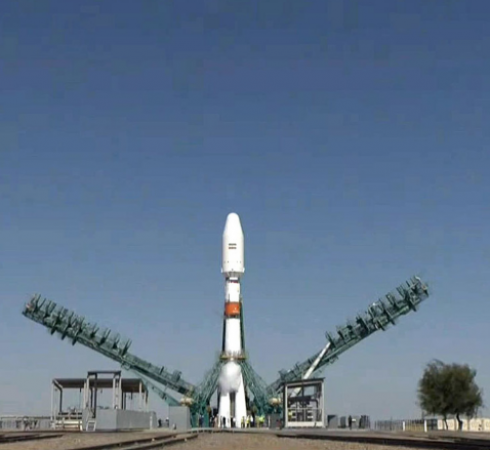
Kazakhstan: Russia launched an Iranian satellite from Kazakhstan early Tuesday, sparking concerns that Moscow could use it to increase surveillance of Ukrainian military bases.
The launch of the Soyuz-2.1b rocket carrying the Khayyam satellite from the Russian-controlled Baikonur Cosmodrome at the scheduled time of 05:52 GMT was visible on the live feed of the Russian space agency Roscosmos. Its subsequent entry into orbit was confirmed by Russian Mission Control.
Iran has acted to address concerns that Moscow may use Khayyam to spy on Ukraine in order to maintain its ties with Moscow and refrain from criticizing the Ukrainian offensive.
Russia plans to use the satellite "for several months or more" to support its war effort before handing over control to Iran, according to The Washington Post, which last week cited unnamed Western intelligence officials was.
However, according to a statement made by the Iranian Space Agency (ISA) on Sunday, the Islamic Republic of Khayyam will command the satellite "from day one".
It said that no third country could access the information because of the satellite's "encrypted algorithm".
According to the space agency, Khayyam will "monitor the country's borders," improve agricultural productivity, and keep an eye on water resources and natural disasters.
The ISA praised the "high reliability factor of the Soyuz launcher" in a pre-launch statement on Monday.
According to a statement on the space agency's website, Russia has been entrusted with the launch of the Khayyam satellite. This is because the satellite weighs more than half a ton and the Soyuz launcher has a very high success rate.
If the satellite is successful in its mission, Iran will be able to keep an eye on its arch enemy Israel and other Middle Eastern countries.
Live coverage of the launch was broadcast on Iranian state television, which also announced that the country's communications minister was present for the liftoff in Kazakhstan.
State television reported that the satellite would deliver high-resolution surveillance images with a definition of one meter per pixel, citing Iran's civilian space agency. Western civilian satellites provide about half a meter resolution per pixel, while US spy satellites are thought to be even higher.
The US is concerned that Iran's military and civilian space programs could be used to advance its ballistic missile program. But in recent years, Iran has experienced several accidents and unsuccessful satellite launches.
Meanwhile, the Kremlin is attempting to move Russia to the Middle East, Asia and Africa and find new clients for the country's troubled space program as Moscow is increasingly isolated internationally as a result of Western sanctions on Ukraine. It is done.
Russian President Vladimir Putin met his Iranian counterpart Ibrahim Raisi and Supreme Leader Ayatollah Ali Khamenei in Tehran last month, on one of his few visits abroad since the invasion began.
Khayyam is believed to have been named after the Persian polymath Omar Khayyam, who lived in the 11th century. This is not the first Iranian satellite that Russia has launched into orbit;
In 2005, Iran's Sina-1 satellite was launched from Russia's Plesetsk Cosmodrome.
Iran is currently attempting to salvage a 2015 agreement to halt Tehran's nuclear aspirations through talks with major world powers, including Moscow.
The United States, which abandoned the historic Joint Comprehensive Plan of Action (JCPOA) in 2018 while Donald Trump was still president, accused Iran of actively maintaining a "veil of neutrality" over Russia's conflict with Ukraine . have put.
Iran's Khamenei called for "long-term cooperation" with Russia during his meeting with Putin last month, and Tehran declined to join the global condemnation of Moscow's invasion of its pro-Western neighbour.
Iran says its space program does not violate the 2015 nuclear deal or any other international agreement because it is used only for defense and civilian purposes.
Western governments are concerned that satellite launch systems contain components that could be used interchangeably in ballistic missiles that could deliver nuclear weapons, something that Iran has consistently denied a desire to develop.
In April 2020, Iran was able to successfully launch its first military satellite into orbit, earning the country strong criticism from the US.
Safety concerns increase after repeated shelling on a nuclear plant
US promises Kyiv an additional $1 billion in rockets and other weapons